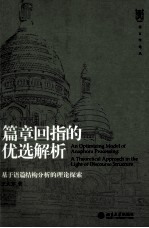图书介绍
篇章回指的优选解析:基于语篇结构分析的理论探索=An optimizing model of anaphora processing : a theoretical approach in the lPDF|Epub|txt|kindle电子书版本网盘下载

- 王大方著 著
- 出版社: 北京大学出版社
- ISBN:
- 出版时间:2013
- 标注页数:203页
- 文件大小:27MB
- 文件页数:217页
- 主题词:
PDF下载
下载说明
篇章回指的优选解析:基于语篇结构分析的理论探索=An optimizing model of anaphora processing : a theoretical approach in the lPDF格式电子书版下载
下载的文件为RAR压缩包。需要使用解压软件进行解压得到PDF格式图书。建议使用BT下载工具Free Download Manager进行下载,简称FDM(免费,没有广告,支持多平台)。本站资源全部打包为BT种子。所以需要使用专业的BT下载软件进行下载。如BitComet qBittorrent uTorrent等BT下载工具。迅雷目前由于本站不是热门资源。不推荐使用!后期资源热门了。安装了迅雷也可以迅雷进行下载!
(文件页数 要大于 标注页数,上中下等多册电子书除外)
注意:本站所有压缩包均有解压码: 点击下载压缩包解压工具
图书目录
CHAPTER 1 INTRODUCTION1
1.1 Anaphora:The Central Notion1
1.1.1 Defining Anaphora in Its Narrow Sense2
1.1.2 Direct Anaphora vs.Indirect Anaphora4
1.1.3 Anaphor-oriented Classification of Nominal Anaphora5
1.1.4 Identity-of-reference Anaphora vs.Identity-of-sense Anaphora8
1.1.5 Intrasentential Anaphora vs.Intersentential Anaphora9
1.1.6 The Scope and Focus of This Study10
1.2 Central Theme and Basic Assumptions of This Study11
1.3 Research Methodology and Data Collection13
1.4 Organization of the Book14
CHAPTER 2 A CRITICAL SURVEY OF RESEARCHES ON DISCOURSE ANAPHORA16
2.1 Linguistic Approaches to Anaphora Distribution in Discourse16
2.1.1 The Textual Approach17
2.1.2 The Pragmatic Approach24
2.1.3 The Cognitive Approach30
2.2 Computational Approaches to Anaphora Resolution43
2.2.1 The BFP Algorithm:A Knowledge-poor Model Based on Centering Theory44
2.2.2 Veins Theory:A Knowledge-based Model Driven by Rhetorical Structure Theory48
2.3 Summary51
2.3.1 Manner of Processing:Hierarchical vs.Linear52
2.3.2 Angle of Approaching:Bidirectional vs.Unidirectional53
2.3.3 Orientation of Modeling:Knowledge-based vs.Knowledge-poor55
CHAPTER 3 AN ANAPHORA-ORIENTED DEPICTION OF DISCOURSE STRUCTURE57
3.1 Grosz and Sidner's Structural Theory:The Guiding Framework57
3.2 Decomposing Discourse:The Foundation Stage62
3.3 Portraying Intentional Structure with RST65
3.3.1 RST:Portraying Discourse Structure with Rhetorical Relations66
3.3.2 Synthesizing RST with Intentional Structure:Nuclearity vs.Dominance70
3.3.3 Categorizing Rhetorical Relations in Terms of Anaphora Processing73
3.4 Modeling Attentional State with CT84
3.5 Summary88
CHAPTER 4 REMODELING ATTENTIONAL STATE WITHIN INTENTIONAL STRUCTURE90
4.1 Specifying the Centering Update Unit:EDU and ARU90
4.2 Idantifying Attentional Center:The Assessment of Salience Weight94
4.2.1 Dynamic Loading of Information:Topic vs.Focus95
4.2.2 The Formal Bias for Referential Prominence:Pronominalization103
4.2.3 The Viewpoint Effect on Salience Denotation:Empathy105
4.3 Accounting for Centering Transition in Terms of Rhetorical Relations108
4.3.1 Alignment Effect108
4.3.2 Parallel Effect111
4.3.3 Garden-Path Effect113
4.4 Modeling Attentional Accessibility within Rhetorical Scope116
4.5 Summary122
CHAPTER 5 THE OPTIMIZATION OF DISCOURSE ANAPHORA IN THE LIGHT OF STRUCTURAL CONSTRAINTS124
5.1 Theoretical Foundation124
5.1.1 Optimality Theory:Providing the Selection Procedure124
5.1.2 Centering Optimality Theory:Reformulating CT within OT125
5.2 The Working Mechanism of GEN128
5.2.1 Identifying Pleonastic Pronouns128
5.2.2 Setting the Search Scope of Potential Antecedents131
5.3 The Working Mechanism of EVAL135
5.4 Empirical Evaluation of the Optimizing Model144
5.4.1 Shallow Processing of the Test Corpus145
5.4.2 Applying the Optimizing Model to Anaphora Interpretation148
5.4.3 Error Analysis162
5.5 Summary166
CHAPTER 6 CONCLUSIONS168
6.1 A summary of My Work168
6.1.1 Defining the Notion Anaphora168
6.1.2 A Critical Survey of Relevant Literature169
6.1.3 Depicting Discourse Structure for Anaphora Processing169
6.1.4 Polishing CT from Local to Global170
6.1.5 Optimizing Discourse Anaphora171
6.2 Contributions of the Study173
6.2.1 Proposing an Anaphora-oriented Structural Model173
6.2.2 Remodeling CT with Better Treatment for Discourse Anaphora173
6.2.3 Formulating an Ideal Resolution System with the Merits of OT174
6.3 Limitations of the Study175
6.3.1 Inexplicit Representation of Knowledge Source and Contextual Information175
6.3.2 Narrow-scale Data Base for a General Framework of Anaphora Processing175
6.4 Future Research Directions176
6.4.1 Cross-linguistic Applicability176
6.4.2 Bidirectional Optimization177
6.4.3 Coherence Evaluation178
Bibliography180
Appendix Ⅰ Definitions of Rhetorical Relations195
Appendix Ⅱ Data Base201
Acknowledgements202